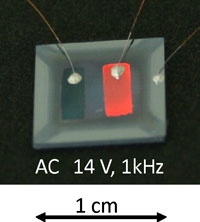Jul 15 2009
Hiroshi Takashima and coworkers of the Superconducting Devices Group of the Nanoelectronics Research Institute, National Institute of Advanced Industrial Science and Technology (AIST) have developed red electroluminescent (EL) devices using thin-films of chemically stable perovskite oxides.
 Light emission from an inorganic EL device with perovskite oxides
Light emission from an inorganic EL device with perovskite oxides
The thin-film EL devices use perovskite oxides, typified by barium titanate (BaTiO3), which has long been used as capacitor material for electronic circuits. With an emission starting voltage of ˜10 V AC, the power source can be downsized due to low voltage operation of the device. A wide viewing angle is obtained by means of plane emission through the entire surface of the transparent electrode. There are no resource constraints due to the global abundance of required materials for the emitting and insulator layers. As all layers including the emitting layer are made of chemically stable inorganic materials, characteristic degradation due to oxidation or heat is unlikely to occur and thus a sealing process can be simplified. Hence, energy will be saved in a manufacturing process. Such applications as lighting, optical sources and displays will become feasible if higher brightness and polychromatic radiation are achieved in the years to come.
The results of this study will be published in the German scientific journal, "Advanced Materials."